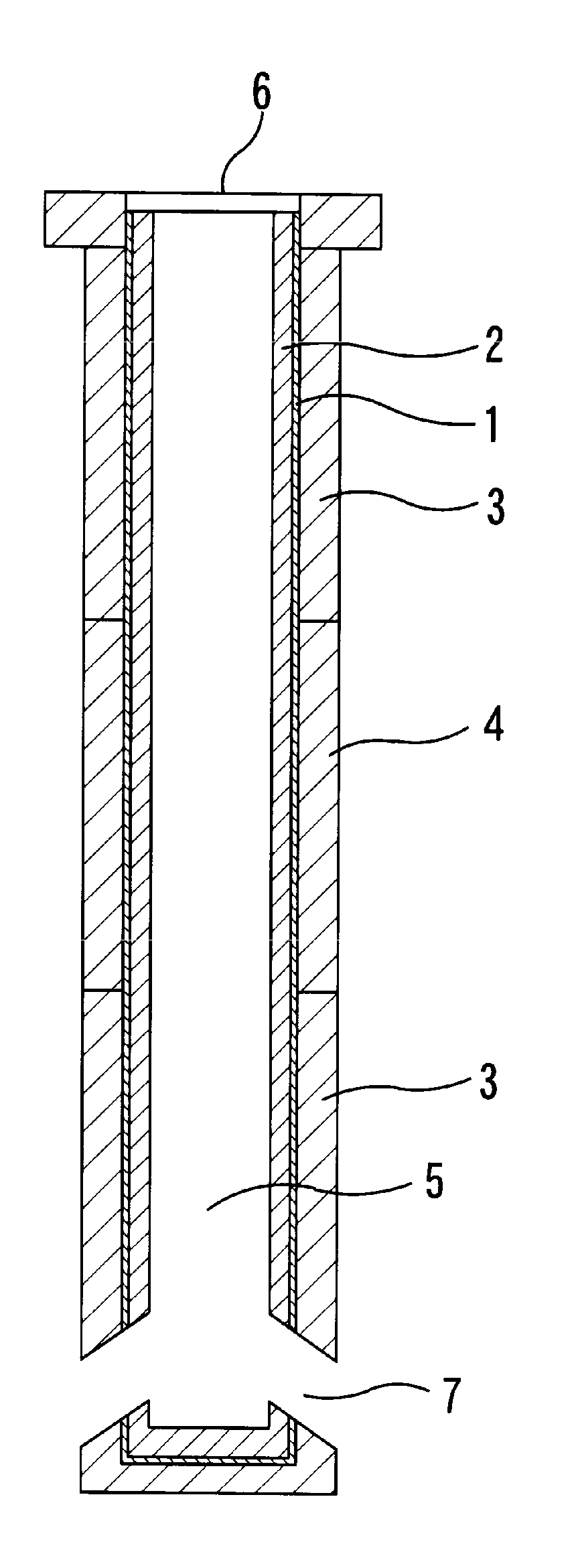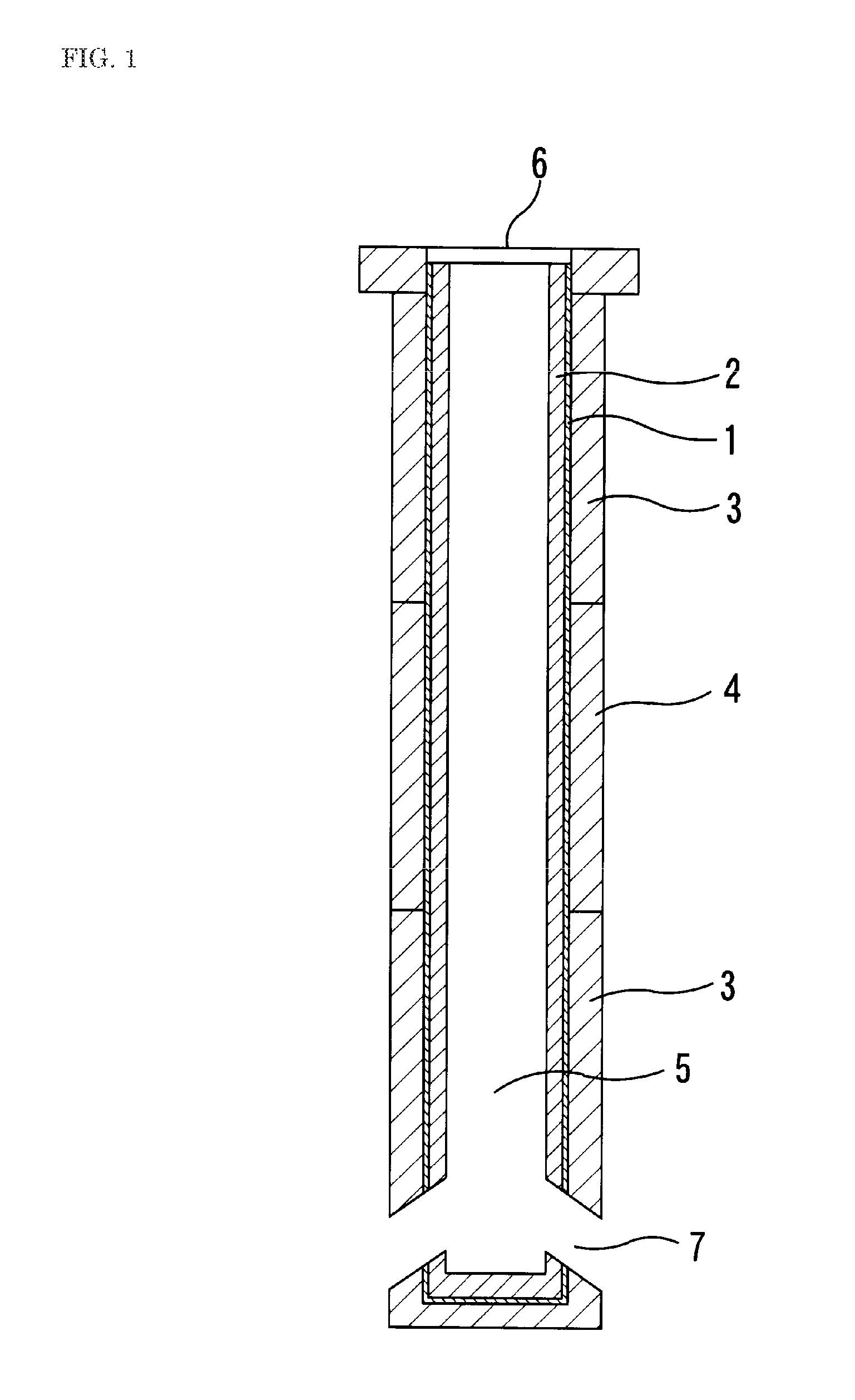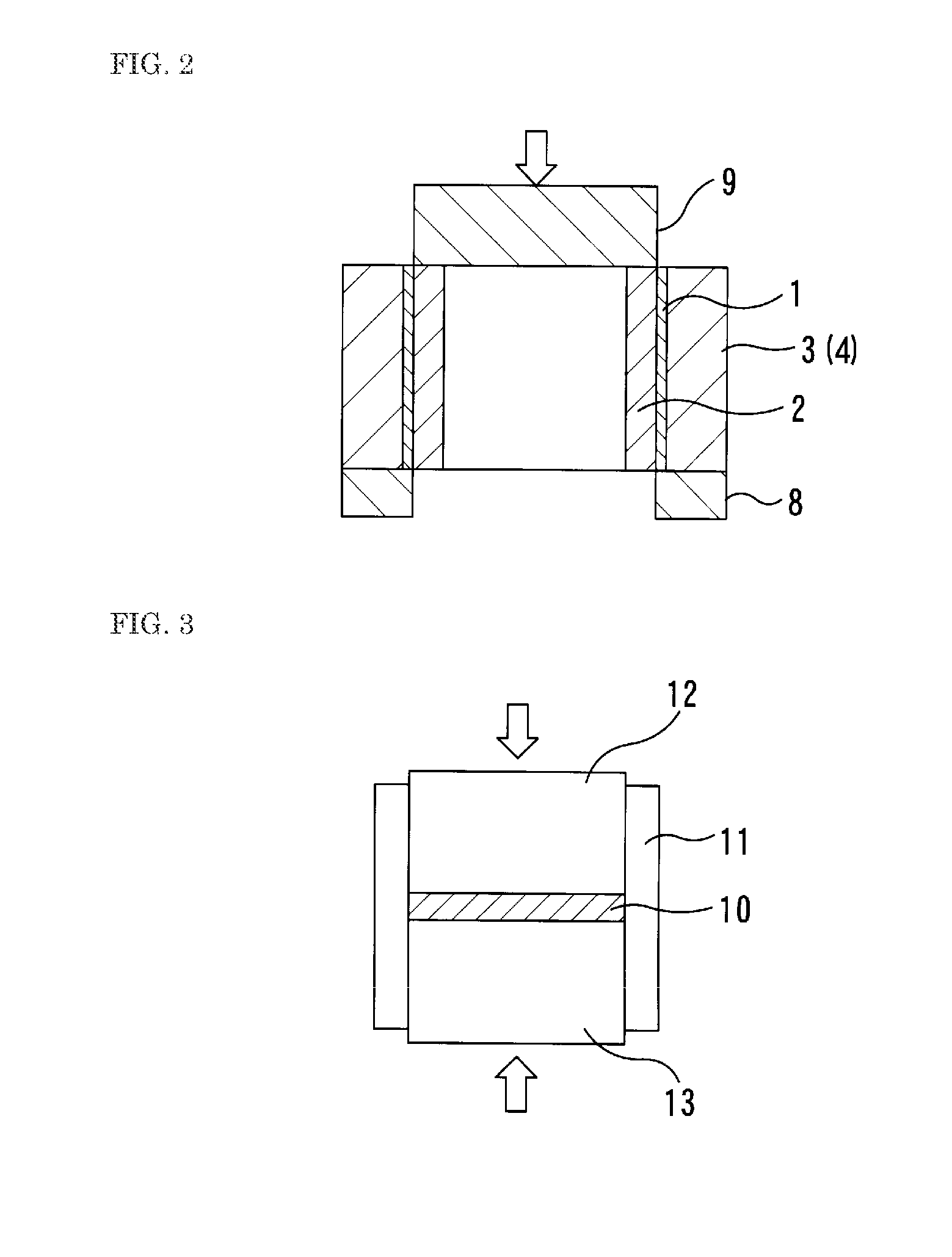Irrespective of whether the refractory member has a single-layer structure or a multi-layer structure, such a
temperature gradient gives rise to a strain due to an
internal stress of the refractory member, which becomes one factor causing breaking, such as
cracking in the outer periphery-side region.
Further, as the
temperature gradient becomes larger, and a thermal expansion coefficient of the inner bore-side region becomes larger with respect to that of the outer periphery-side layer, a thermal stress will be increased to cause a higher risk of breaking, particularly, in the outer periphery-side region.
This has a
disadvantage of giving rise to deterioration in durability, such as
erosion (abrasion) resistance and
corrosion resistance, particularly, of the inner bore-side region.
A continuous casting nozzle is used under a condition that a
molten steel flow passes through an inner bore thereof, while violently colliding against an inner bore surface thereof Thus, a region of the continuous casting nozzle adjacent to the inner bore surface will be particularly severely damaged due to abrasion (
erosion) caused by the molten steel, non-
metal inclusions in the molten steel, etc., structural
embrittlement and washing (
corrosion) caused by oxidizing components of the molten steel, etc., and melting loss caused by a
reaction product with FeO and other components of the molten steel.
Moreover, due to an increase in thermal gradient caused by an increase in
thermal conductivity of the inner bore-side layer with respect to the outer periphery-side layer as a result of the reduction in carbon content, a difference between respective thermal expansion amounts of the inner bore-side layer and the outer periphery-side layer, and a resulting thermal stress, are apt to be more increased, which leads to a higher risk of breaking of the continuous casting nozzle, particularly, the outer periphery-side layer.
However, in the above adjustment technique, a large amount of liquid (
solvent and binder) is required to obtain a
high stress relaxation capability, so that the
mortar is liable to have fluidity.
For example, this has a
disadvantage of significant deterioration in shape retainability of the
mortar to cause difficulty in ensuring a required thickness of a mortar layer or a fully filled state of the joint region.
More specifically, in an operation of installing an inner bore-side layer in a nozzle body (i.e., an outer periphery-side layer) of a continuous casting nozzle, using such mortar having a high fluidity or low shape retainability, it is highly likely that the inner bore-side layer is displaced to cause an undesirable situation where the mortar layer has a region having almost no thickness, a region having an excessively large thickness, and / or a large number of void spaces.
This situation precludes a possibility to ensure required capabilities, such as the
stress relaxation capability and a capability of preventing molten steel and other foreign substances from intruding into the joint region, which leads, particularly, to breaking of the outer periphery-side layer and drop-off of the inner bore-side layer.
Thus, even if the inner bore-side layer can be fixed to the outer periphery-side layer (nozzle body of the continuous casting nozzle) in an intended relative arrangement through the mortar layer, the mortar layer is likely to be broken not only by an expansion force during
stress relaxation under a hot condition but also by a weak external force during handling of the nozzle, to cause difficulty in maintaining
structural stability.
This gives rise to a problem that peeling, displacement or the like of the inner bore-side layer is likely to occur.
This gives rise to another problem that molten steel,
slag component and other foreign substances are infiltrated in the mortar layer through the pore (including a broken and enlarged pore) as a pathway to cause melting loss or breaking of the mortal layer itself.
Thus, the liquid is liable to be absorbed in target refractory
layers to be bonded, to cause a change in concentration of a
solid content of the mortar.
This means that, if each of adjacent refractory materials has a different apparent
porosity, a
solvent contained in the mortar to provide flexibility and bindability thereto is absorbed in the refractory materials through contact therewith, and thereby
compressibility and
bonding strength of the mortar are changed in each region, which gives rise to a problem that the
compressibility and bonding capability become instable depending on adjacent refractory materials and a thickness of a
mortar joint.
Further, during a course of the absorption and
drying, the liquid is liable to cause a problem that shrinkage or crack occurs in the mortar layer itself, or gap or peeling occurs between the
molar layer and each of the target refractory layers.
Moreover, along with a reduction of amount of the liquid in the mortar, aggregate particles will
agglomerate together, which is likely to give rise to a problem concerning bonding capability due to a higher risk of the occurrence of crack, peeling or the like in the mortar layer.
If the bonded region is set at zero %, it causes a fundamental problem that the inner bore-side layer cannot be structurally supported.
Moreover, in the separation layer in the
Patent Document 2, i.e., a so-called hollow joint, molten steel easily intrudes into a
void space of the joint, which gives rise to problems, such as cracks in the refractory layers due to solidification shrinkage of the molten steel occurring when it undergoes changes in temperature and expansion of the solidified steel occurring when it is heated, and peel-off of the inner bore-side layer due to no bonding between the inner bore-side and outer periphery-side layers.
Particularly, in a continuous casting nozzle comprising an inner bore-side layer, an intermediate layer and an outer periphery-side layer, where an MgO—CaO based material is used for the inner bore-side layer, depending on respective compositions of the inner bore-side layer and the intermediate layer, a damage, such as melting / washing, is rather likely to occur beyond a bonded region where the inner bore-side layer is in direct contact with the intermediate layer, which causes problems, such as melting loss, peel-off or reduction in fixing strength of the inner bore-side layer,
breakup of the intermediate layer, formation of a hollow space between the inner bore-side and outer periphery-side layers, and intrusion of molten steel into the hollow space.
However, any mortar layer having all the capabilities has not yet been obtained.[
Patent Document 1] Pamphlet of International Publication No. 03 / 086684[
Patent Document 2] JP 7-232249A
 Login to View More
Login to View More 


